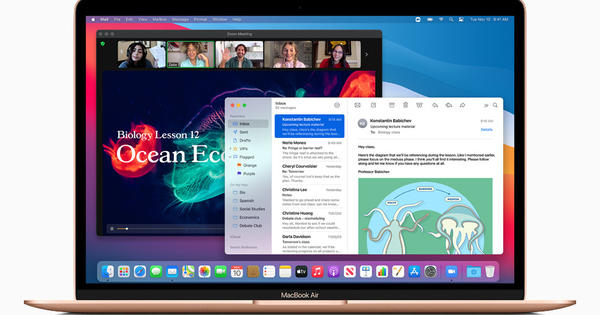A fast network connection is not a luxury, but what if you can't pull network cables? If you do have a coax cable for television, the Hirschmann INCA 1G promises to be a solution for a gigabit network connection. We have tested for you whether this is really the case.
Hirschmann INCA 1G
Price €69.96 (single adapter), €115.95 (set of two adapters)Connections 2x IEC coax connection, micro USB connection, gigabit network connection
Technic Bonded MoCa 2.0 (1 Gbit/s)
Website www.hirschmann-multimedia.com 9 Score 90
- Pros
- Full gigabit speed
- Easy to connect
- Compact and sturdy housing
- Low energy consumption
- Negatives
- Encryption not adjustable
The technique with which you can use a coaxial cable for television for network signals is called MoCa. The tested INCA 1G is not Hirschmann's first MoCa adapter. In 2013, we tested the Moka 16, which was followed a few years later by the Moka 32. With the Moka 16, Hirschmann promised speeds of 175 Mbit/s, with the successor 400. Mbit/s and with this INCA 1G we find a promised speed of no less than 1 Gbit/s on the packaging. We know from previous experiences with the predecessors of the INCA 1G that the speeds of the MoCa adapters, in contrast to those of powerline adapters, are very close to the promised speeds. Coaxial cables, unlike power cables, are designed for signal transmission and shielded from outside interference. The INCA 1G is also compatible with Hirschmann's earlier MoCa adapters, the connection speed is of course limited by the older adapter.

Operation
The INCA 1G is a compact metal box with a size of 11 x 4.6 x 2 centimeters that you can optionally screw to the wall with a screw. On the top you will find two IEC coax connections, while the bottom has a network port and micro USB connection for the power supply. Just like with the well-known powerline adapters, you need at least two MoCa adapters to use the technology. You usually place one in the meter cupboard near your router and the other you install in the place where you need a network connection. Of course, a coaxial cable must run to that location. That is directly the most important limitation of MoCa technology: you usually have a limited number of coax connections at home. An active cable subscription is not necessary, a coax cable from the meter cupboard to the user room is enough to use the adapters. In addition to the individual adapters, Hirschmann also sells a set of two adapters in one package, the INCA 1G white SET, which can be purchased for around 130 euros. A MoCa network can consist of up to sixteen adapters.

Easy connection
Connecting the adapter is very easy. Where the previous variants of Hirschmann's MoCa adapters used the f-connectors usual for satellite television, the Inca 1G is equipped with the IEC connectors usual for cable television. Handy, since most coax networks in the home will be for cable TV. If you have cable television, you connect a cable to your subscriber transfer point on one coax connection and connect the other connection with the coax cable that runs to the point where you install the second adapter. Of course you also connect a network cable to your router. On the other hand, connect the adapter to the wall socket with a coaxial cable and if you have cable television, connect your television or television receiver to the second coax connection. You can then connect your network equipment to the network connection.
The INCA 1G adapters, like the predecessors, do not have the possibility to set a unique encryption key, something that the technology can do in itself under the name MoCa Protected setup. According to Hirschmann, the data signals do not go past the subscriber transfer point, but we would still think that setting an encryption key ourselves would be a safe idea.

Results
We have tested the INCA 1G in practice at home on the coax connection in our living room. In the wall is a coax cable of about 25 meters that was installed about thirteen years ago. The wall socket has recently been replaced by something modern, the Braun Telecom btv 01. The cable ends in the meter cupboard where the router is also installed.
When installed, the coax cable incorporated into the wall was probably an excellent cable, but in 2020 it is certainly not the best shielded cable on the market. An excellent test situation, because the INCA 1G is intended for situations where you do not want to run new cables. In our benchmark we achieve a speed of 949 Mbit/s or, as promised, a full gigabit speed without any problems. An impressive performance that cannot be matched by any powerline adapter. If you can choose between MoCa or powerline, then definitely go for MoCa.
The MoCa adapter is then connected to a switch in the television cabinet to which various equipment is connected. In practice everything turned out to work fine. The power consumption of the adapters is limited to 3 watts each. A 1 amp (5 watt) USB charger is included. However, we didn't have a free socket in the meter cupboard and we connected the USB cable from the INCA 1G to a USB port on the router. This turned out to be no problem.
The MoCa signal has no influence on television signals: the television reception is also excellent with connected adapters. The frequencies used for the MoCa technology are therefore outside those of the frequencies used by the cable providers.
Conclusion
With the INCA 1G, Hirschmann is launching an excellent alternative to a normal network cable that allows you to set up a gigabit connection without any problems. Something that we have never been able to do with a powerline adapter and that is because a coaxial cable is designed for signal transfer. A disadvantage is that the encryption cannot be set yourself, although the signals do not go beyond the aop according to Hirschmann.
The biggest drawback of this excellent technology remains that you probably have a limited number of coax connections in your house that you can turn into a network connection with this INCA 1G. If you happen to have a coax connection in the right place, then this is the best solution for realizing a fast and stable network connection without pulling network cables.

